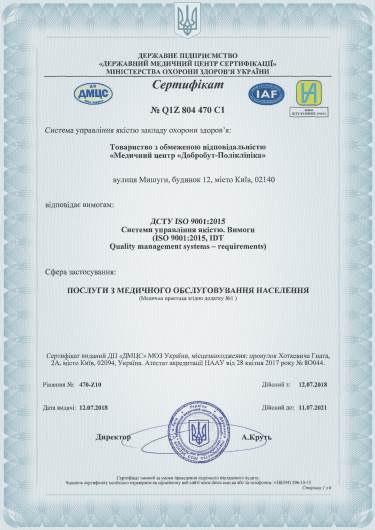Cervical cancer
Cervical cancer is in top-10 of the most common female oncological diseases.
Usually cervical cancer develops slowly, for years. Cervical tissues suffer changes at the cellular level before cancer cells of the cervix begin to grow. The treatment at this precancerous state means removal of damaged cells.
There are two types of cervical cancer:
- squamous cell carcinoma . This type of cervical cancer is more common, it embraces 70% of all the cases.
- adenocarcinoma . This type of cervical cancer embraces 25% of all the cases. Adenocarcinoma originates from the cells of the mucus-producing glands that cover the endocervix.
Cervical cancer symptoms
Cervical cancer often shows no symptoms, especially at its earliest stages. As it can remain hidden, it is important to undergo a cervical cancer screening if you are older than 21.



You should immediately see a gynecologist if you have the following symptoms:
- pain or bleeding during or after sex, vaginal douching or pelvic examination;
- pain in the pelvic area;
- unusual vaginal discharge;
- blood or bleeding outside of your usual period.
Risk factors
More than 90% of cervical cancer cases today are caused by the human papilloma virus (HPV). HPV is a rather wide-spread disease, up to the third of men and women are infected. The virus can be spread through the physical contact with the infected area of mouth, genitalia and anus. American Cancer Society informs that the use of condoms can reduce HPV infecting level for of about 70 percent. The only effective way of HPV prevention is vaccination.

- the first sexual intercourse at an early age;
- several sexual partners;
- birthing of three and more children;
- use of oral contraceptives;
- cigarette smoking (it creates chemical substances that can damage cervical cells);
- infecting with the human immunodeficiency virus (HIV).
Prevention of cervical cancer
Some of the ways of cervical cancer prevention are preventive examinations and screenings.
At one time cervical cancer was considered one of the most dangerous types of female oncological diseases. Due to the effective screening with Papanicolaou vaginal swabbing (PAP test) now it is possible to detect cancerous growths on the cervix as early as possible.

PAP test allows to detect any changes in cervical cells, presence of HPV included. Early detection can influence on the course of treatment.
Dobrobut clinic chain specialists recommend to undergo the PAP test annually for all the women over 21.
Early detection of cervical cancer
If the PAP test has revealed pathological changes of cells, you should consult a gynecologist and undergo additional diagnostic examinations: colposcopy and biopsy.
Biopsy can be performed together with the process of removal of the pathologically changed part of the cervix.
Cervical cancer phases:
- the first phase of cervical cancer is the carcinoma in situ (also known as precancerous or severe dysplasia), when the group of ill-defined cells has started to grow but has not spread to adjacent tissues yet.
- early cervical cancer (stages I-IIA) is usually more extended than stage 0, however, cancerous growths are still restricted to the cervix.
- locally advanced cervical cancer (stages IIB-IVA) is the cancer spread beyond the confines of the cervix to the adjacent tissues such as vagina, rectum and urinary bladder.
- IVB stage means cancer spread beyond the pelvis (for example, to lungs or liver).
Having confirmed the diagnosis and determined the phase of the disease, a doctor can prescribe additional diagnostics: computerized tomography of thoracic, abdominal and pelvic organs, contrast-aided MRI of small pelvis that will help to determine the presence and the phase of the disease, to assess the tumor extension beyond the cervix in other parts of the body.
A doctor prescribes a treatment on the basis of the data received during diagnostics and individual characteristics of a patient. A choice of treatment approach at Dobrobut oncological center is always approved by a multidisciplinary oncological concilium.
Bibliography
- Chang S.S., Cole E., Cookson M.S. et al. Preservation of the anterior vaginal wall during female radical cystectomy with orthotopic urinary diversion: technigue and results. / J. Urol. – 2002. – Vol. 168. – P. 14421445.
- Курашвили Л. Р. Руководство к практическим занятиям по биопсийносекционному курсу (клиническая патанатомия): учебное пособие. – М.: Издательский дом Академии Естествознания, 2012. – 74 с
- Альперович Б.И., Журавлев В.А. Дискуссия о методах резекции печени // Анн. хир. гепатол. – 2005, № 1. – С. 18-26.
- Аляев Ю.Г., Винаров А.З., Крапивин А.А. Диагностика опухоли лоханки и мочеточника. В кн.: Тезисы VI Всероссийской научно-практической конференции Актуальные вопросы лечения онкоурологических заболеваний 4-5 октября 2005 г. Онкоурология (приложение) 2005: прил.: 5-6.
Our advantages
Our services
Service packages
Our gynecologists
Choose the nearest clinic to you
ISO certificates



Accreditation certificates



Medical practice licenses































%402x.png)
%402x.png)
